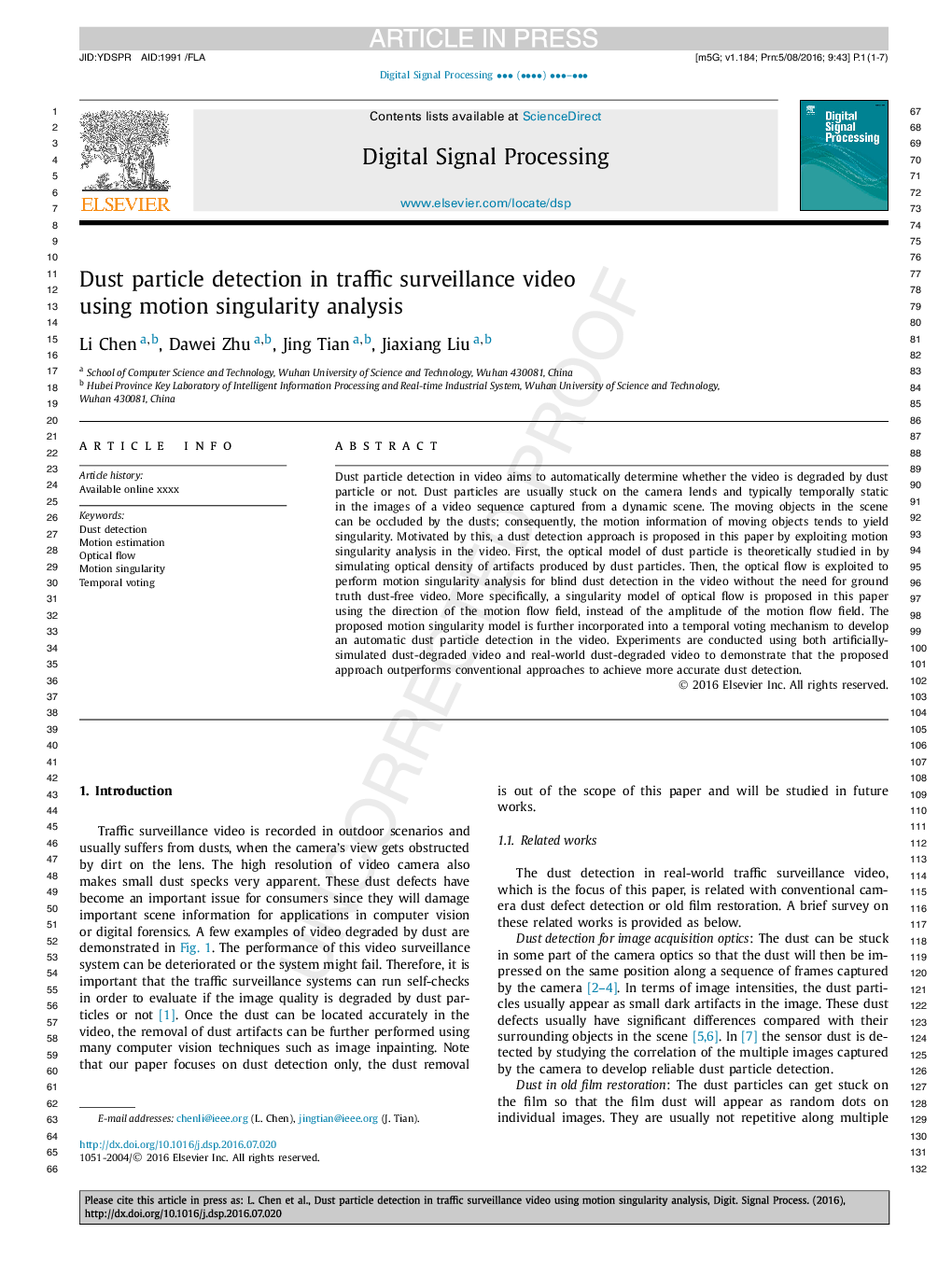| کد مقاله | کد نشریه | سال انتشار | مقاله انگلیسی | نسخه تمام متن |
|---|---|---|---|---|
| 6951927 | 1451722 | 2016 | 7 صفحه PDF | دانلود رایگان |
عنوان انگلیسی مقاله ISI
Dust particle detection in traffic surveillance video using motion singularity analysis
ترجمه فارسی عنوان
تشخیص ذرات گرد و غبار در ویدیو نظارت تصویری با استفاده از تجزیه و تحلیل تکینگی حرکت
دانلود مقاله + سفارش ترجمه
دانلود مقاله ISI انگلیسی
رایگان برای ایرانیان
کلمات کلیدی
تشخیص گرد و غبار، برآورد حرکت، جریان نوری، تکینگی حرکت رأی موقتی
ترجمه چکیده
تشخیص ذرات گرد و غبار در ویدیو به طور خودکار تعیین می کند که آیا ویدئو توسط ذرات گرد و غبار تضعیف شده است یا نه. ذرات گرد و خاک معمولا روی دوربین قرار می گیرند و معمولا در تصاویر یک توالی ویدئویی ضبط شده از یک صحنه پویا به طور موقت ثابت می شوند. اجسام متحرک در صحنه می توانند توسط گرد و غبار بسته شوند؛ در نتیجه، اطلاعات حرکت از اشیاء متحرک تمایل به انجام تکلیف. در این مقاله، با استفاده از تحلیلی تکینگی حرکت در ویدیو، بر اساس این رویکرد، روش شناسایی گرد و غبار در این مقاله پیشنهاد شده است. ابتدا مدل نوری ذرات گرد و غبار به صورت تئوری به وسیله شبیه سازی تراکم نوری مصنوعات تولید شده توسط ذرات گرد و خاک مورد مطالعه قرار گرفته است. سپس، جریان نوری برای انجام تجزیه و تحلیل تکینگی حرکت برای تشخیص گرد و غبار کور در ویدئو بدون نیاز به حق پخش زمین بدون حق غبار بهره برداری می شود. به طور خاص، یک مدل تکینگی جریان نوری در این مقاله با استفاده از جهت میدان جریان حرکت، به جای دامنه میدان جریان حرکت پیشنهاد شده است. مدل تکینگی حرکت پیشنهادی بیشتر به یک مکانیزم رأی گیری زمانبندی برای ایجاد یک ذره خودکار ذرات گرد و غبار در ویدیو متکی می شود. آزمایش ها با استفاده از تصاویر مصنوعی شبیه شده غبار پراکنده شده و تصفیه گرد و غبار در دنیای واقعی انجام شده است تا نشان دهند که رویکرد پیشنهادی از روش های معمولی برای دستیابی به دقیق تر کردن گرد و غبار بهتر است.
موضوعات مرتبط
مهندسی و علوم پایه
مهندسی کامپیوتر
پردازش سیگنال
چکیده انگلیسی
Dust particle detection in video aims to automatically determine whether the video is degraded by dust particle or not. Dust particles are usually stuck on the camera lends and typically temporally static in the images of a video sequence captured from a dynamic scene. The moving objects in the scene can be occluded by the dusts; consequently, the motion information of moving objects tends to yield singularity. Motivated by this, a dust detection approach is proposed in this paper by exploiting motion singularity analysis in the video. First, the optical model of dust particle is theoretically studied in by simulating optical density of artifacts produced by dust particles. Then, the optical flow is exploited to perform motion singularity analysis for blind dust detection in the video without the need for ground truth dust-free video. More specifically, a singularity model of optical flow is proposed in this paper using the direction of the motion flow field, instead of the amplitude of the motion flow field. The proposed motion singularity model is further incorporated into a temporal voting mechanism to develop an automatic dust particle detection in the video. Experiments are conducted using both artificially-simulated dust-degraded video and real-world dust-degraded video to demonstrate that the proposed approach outperforms conventional approaches to achieve more accurate dust detection.
ناشر
Database: Elsevier - ScienceDirect (ساینس دایرکت)
Journal: Digital Signal Processing - Volume 58, November 2016, Pages 127-133
Journal: Digital Signal Processing - Volume 58, November 2016, Pages 127-133
نویسندگان
Li Chen, Dawei Zhu, Jing Tian, Jiaxiang Liu,
